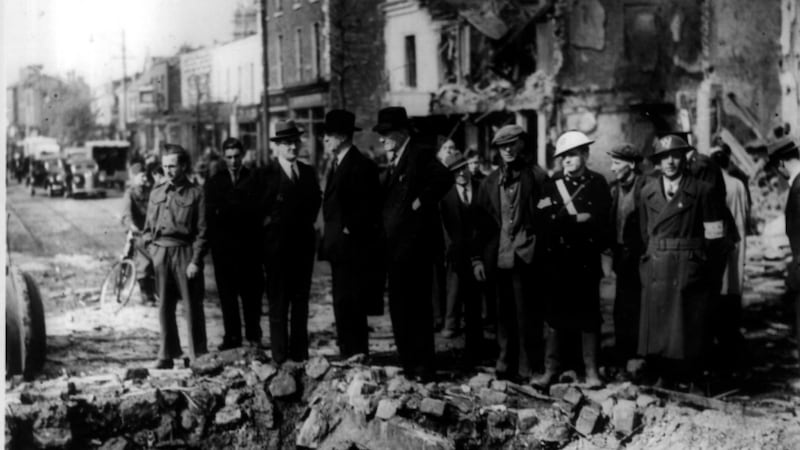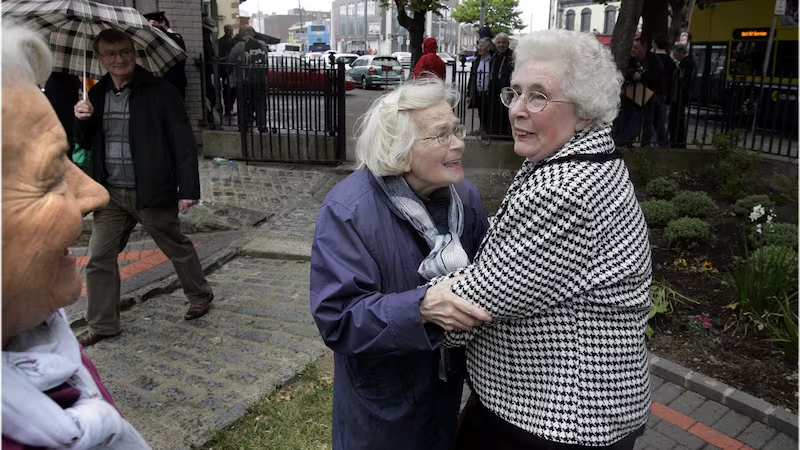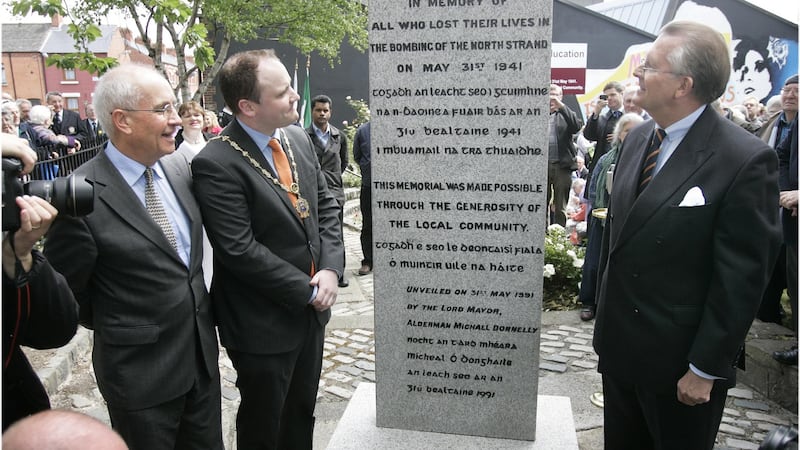During the early hours of Saturday, May 31st, 1941, Mary Tarrant awoke to a loud thumping of Bofors anti-aircraft guns firing into the sky. The 32-year-old daughter of a prominent, Dublin-based livestock merchant got up and went to her stepmother's room.
“Well sure there’s an awful lot of banging going on and noise,” she said excitedly. Her stepmother, who was concerned for the safety of Mary’s brother, who had gone out that night, replied, “I think we’ll go down and make a cup of tea.”
Irish air observers had earlier detected significant numbers of Luftwaffe aircraft in the skies over Dublin; these aircraft were not in formation and appeared to be circling erratically over the city. Searchlights were switched on to track the intruders and a series of flares were fired – tricolour flares to indicate to the German crews that they had entered Irish sovereign airspace, followed by red flares to signal to depart immediately or be fired upon. These signals went unheeded and the anti-aircraft batteries around Dublin Bay opened fire.

German aircraft had been transgressing Irish airspace for nefarious purposes in recent months. Earlier in the year, on January 2nd and 3rd, German bombs were dropped on Terenure and Donore Terrace. Both incidents were clearly deliberate attacks, as both areas held sizeable Jewish populations, with what seemed like a precision strike at Donore Terrace causing damage to the Jewish synagogue. Although there was no loss of life, 21 people were seriously injured and there was considerable property damage.
In addition, Belfast had been raided intensively during four nights throughout April and May, with the worst raid, on the night of April 15th-16th, resulting in more than 800 fatalities. More than 1,100 people ultimately lost their lives in the Greater Belfast area, and more than 110,000 had been "de-housed" by the Blitz. Many thousands of these homeless refugees poured south on the Belfast-Dublin train, arriving at Amiens Street Station (now Connolly Station), seeking the assistance of the Irish Red Cross and the government of then taoiseach Eamon de Valera.
News reports and images of seemingly endless trainloads of Belfast refugees stepping on to the platforms of Amiens Street were widely publicised internationally, possibly provoking embarrassment in Berlin, as well as highlighting the tangible assistance that neutral Ireland was rendering to Northern Ireland, and by extension, the UK, in their hour of need. It was also no secret that this train station was the key point of departure for the hundreds of Irish nationals who journeyed north every week, either to enlist in the British forces or to find employment as civilian workers in Belfast's war industries.

According to Irish Army Col Edward Flynn, a second cousin of Frank Aiken, then minister for co-ordination of defensive measures, the notorious Nazi propagandist William Joyce, known as Lord Haw-Haw, had broadcast one of his famous "pre-warnings" that Amiens Street Station would be bombed in the preceding weeks. Joyce had delivered similar warnings in advance of the Blitz on Belfast and as a prelude to a bomb attack on Dundalk on July 4th.
Explosion
At 2.05 on the morning of May 31st, Mary Tarrant and her stepmother were making their tea in the basement kitchen of their home at Number 5 Seville Place, located just off Amiens Street, when the bomb exploded.
“As I got making the tea in the kitchen, I heard the whistle. And I guessed what it was – I’d never heard a bomb before but I just read about it. I could hear this whistling sound. And we were in a room that was luckily protected in a way because there was a kind of – you know, it was like an old house with a basement to it. So, we were in a room that had leaded window and . . . that window didn’t blow in,” Mary recalled. “But it was frightening . . . we were saying our prayers, I can tell you that.”

This bomb was the last of four dropped on the city that morning. The first detonated in the Ballybough area at 1.28am, demolishing two houses, 43 and 44 Summerhill Park, and causing many injuries, but with no loss of life. The second fell in the Phoenix Park, blowing up the Dog Pond pumping works at the zoo and causing damage to Áras an Uachtaráin, but again with no casualties. The third landed on the North Circular Road near Summerhill, leaving a large crater. The final bomb was dropped from an aircraft that had flown in a loop around the city as far north as Collinstown, attracting both "ack-ack" (machine gun fire) and Bofor's shellfire as it made occasional low swoops over the city centre. It seems that the pilot and navigator of the bomber were trying hard to find their target.
After weaving through searchlight beams and anti-aircraft shellburst patterns for more than half an hour, the bomber discharged its payload. The explosion ripped through the North Strand Road, obliterating 17 houses, and severely damaging 50. The worst damage from the blast was visited on the neighbourhood between Newcomen Bridge and Seville Place, where Mary and her stepmother were thrown to the ground by the shockwave.
“They came right over Dublin so they were straight over our house. All our windows and our doors, our front doors, were blown open,” Mary recalled, in an interview with the Imperial War Museum. “The ambulance people came around to see if we were alright . . . the bombs, you know, they sprayed out the cobble stones and the tram lines and that. Of course, they hit houses. I think there were – where about 14 people lived – killed in a main street near us.”
The impact of the bomb blast was catastrophic. Twenty-eight people perished, with 90 injured. A total of 300 houses were destroyed or damaged beyond repair, leaving 400 people homeless. Eight of the victims were from the same family, the Browns. Their home was near the epicentre of the blast and the entire family was wiped out. The following day revealed the extent of the damage. Bewildered Dubliners surveyed demolished and half-collapsed houses and stared into a bomb crater that was about 15ft deep and some 50ft in diameter. Many mumbled nervously of the destruction that would be visited on Dublin were Hitler to make full war on neutral Ireland.
On June 5th, de Valera and members of his cabinet attended a mass funeral of 12 victims of the bombing. Later that day, he informed Dáil Éireann that an official protest, delivered to German diplomat Dr Eduard Hempel, had been registered in Berlin. However, little further was mentioned of the incident thereafter. Long interpreted as a simple navigation error by German pilots, and cited by Winston Churchill after the war as an example of British signals jamming, known as the Battle of the Beams, the tragedy was interpreted as a simple accident or, at best, a shot across the bow to remind the neutral Irish state of the destruction and carnage that awaited should the government opt to go to war with Nazi Germany, or to place the nation on an overtly pro-Allied footing.
Moreover, it may well be that the fourth bomb dropped on the North Strand had actually been intended for Amiens Street Station, with the probable objective of disabling this vital rail terminal, disrupting the exodus of bombed-out refugees from Belfast to Dublin and bringing a pause to the constant flow of Irish recruits to the British forces going the opposite direction.
If the latter motive was, indeed, Berlin's original intention for authorising an attack on Dublin, it had quite the opposite effect upon Mary Tarrant. A few weeks later, she walked into the station, boarded a train to Belfast and joined the Royal Air Force.










